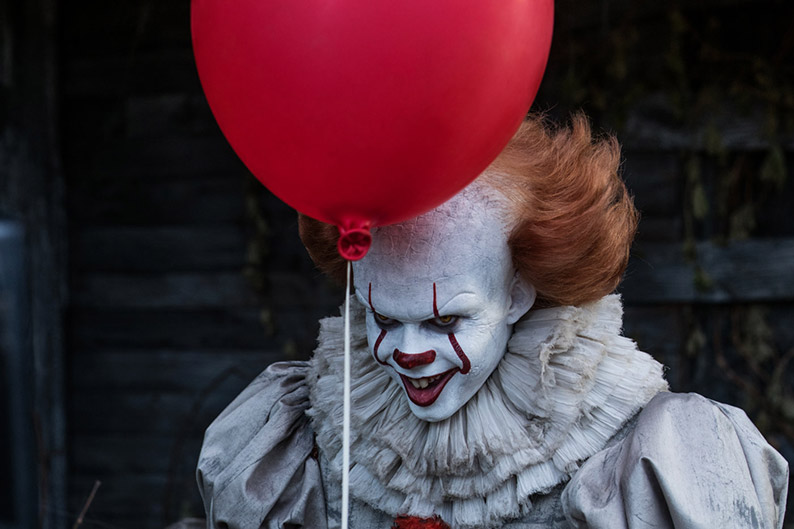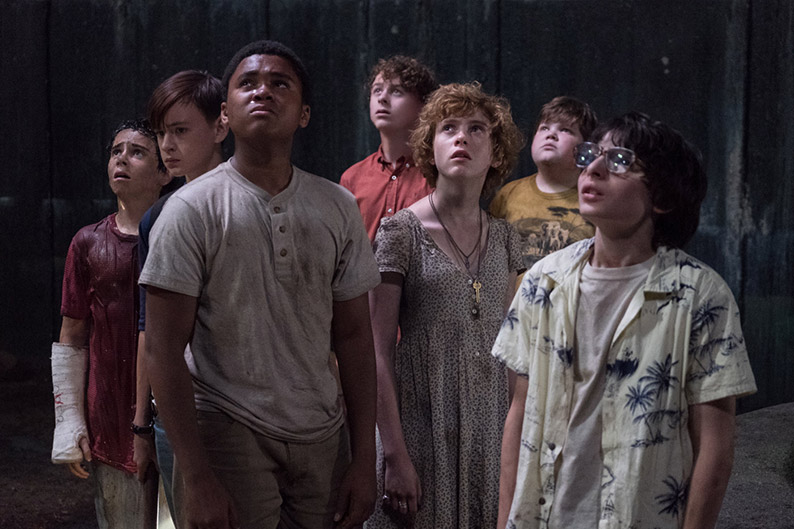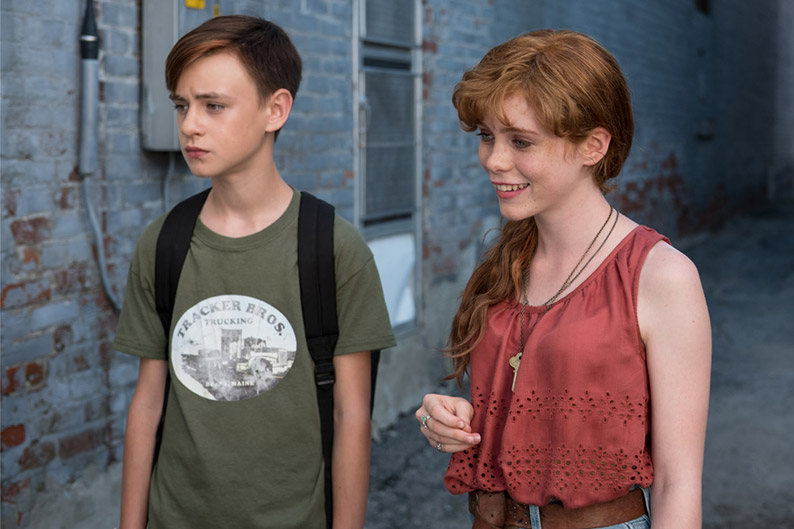|
I was eight years old when the first adaptation of Stephen King's It was shown on television. I remember with blood-curdling clarity how the advert for its coming alone filled me with dread. It was a good few years before I became courageous enough to actually watch the thing and in doing so I opened myself up to a whole new level of terror. I attempted to read the book but at the time it was too long and too frightening for me to conquer. I have never attempted it again (following reference to the book comes from consulting a few sources who know the text well). But the whole thing had a lasting impact on me and I remember the mini-series as something one can only view through the mystical lens of childhood. I have re-watched it a couple of times but afforded it special consideration when coming to view the new adaptation. Unsurprisingly, it doesn't quite stand up to my memories, although it does still tick most of the boxes that made it appealing to my younger self. The first half does at least, which is the part of the book the new feature covers and what this article is concerned with.
So with this in mind, coupled with the cynicism I have for any recent remake or re-working, I went into It (2017, directed by relative newcomer Andy Muschietti) with more than a little trepidation – and as it turned out, largely with good reason...
Before delving into my assessment of the movie I will give a brief synopsis for those few individuals not yet exposed to the Pennywise story. In a sleepy town called Derry, children start going missing, and a group of kids, united by their outsider status (they call themselves The Losers' Club), go in search of the culprit, a supernatural malevolent force that comes to kids in the form of their greatest fears. They find strength in numbers and their friendship weakens the creature, whose default appearance is that of a clown called Pennywise. They track it to its lair and manage to defeat it with a combined effort and a lack of fear, although it is uncertain whether the beast is dead or merely wounded, so they make a pact to reunite and finish it off if it ever were to come back.

This is the basic narrative that both screen adaptations and the source novel all follow, yet there are a lot of things that differ from one version to the next. There are structural differences, as the novel and the TV version begin in the present day, when all the characters are adults and the childhood part of the story is told via flashbacks by the various characters. This lends itself well to a longer format, and creates tension in the novel and translates well to the three hour running time of the TV version. The new film just tells the story chronologically, and that's fine for its cinematic linear storytelling and the fact that it sets aside the adult part of the story for a separate sequel.
The first scene of the film is an almost exact replica of the first flashback scene in the 1990 version. There are videos online showing the two side by side to make this point. I don't have a problem with this as it is an important starting point in the narrative. It is in this scene that Pennywise makes his chilling entrance to the story. It would be impossible to go any further without mentioning the original portrayal of Pennywise, by Tim Curry. It has become iconic, and his recasting here has been the most talked about thing concerning the film. The filmmakers were under a lot of pressure to create a version of the clown that stood up to Curry's, and early teaser photos were tantalising. Yet although I see nothing especially wrong with the visual re-imagining or the performance by (the much younger) Bill Skarsgard, it failed to ignite even a flicker of unease inside that inner child who still fears the Curry version. I am fully aware that nostalgia may be clouding my judgement, but the bar was set high and it would have had to be something very special to surpass Tim Curry's classic performance. I think much of it comes down to how in Curry's version there was more of an actual performance going on. Skarsgard's is often limited to grinning malevolently and letting the CGI do the rest. (His voice is a more inflected approximation of Curry's, which I found disappointing – a reinvention of the character should have included a little more of a reinvention of his sound, as well as his image.) In the one with a 1990s TV budget, Pennywise had to sell his menace with less to help him in way of effects. This film has unfortunately reduced the character to stock modern horror monster/ghost baddie. His stilted motion and jump-scare deployment could be anything post-Ringu remake in the flattened creative landscape of Hollywood frighteners. His sudden bolting toward camera in a computer generated broken flail, accompanied with loud clanging noise, is startling I concede, but not scary. This is a trope of recent horror cinema that has many a true lover of the genre sighing with a disappointment that has become so frequent it is nearing apathy. Actually, both versions suffer from the same scare sequence repetition – a kid becomes isolated, Pennywise turns up, scares the kid, but is ultimately ineffectual. It is in these scenes that the direction would allow a bit of room for Curry to perform using only his costume, voice and bodily movements, but in the new film it is here where CGI and jump scare noises take over.

Moving on to the main ensemble cast, The Losers' Club gel reasonably well, shown most effectively with the banter between the kids, which is a lot more naturalistic than the older adaptation, containing a lot of very adolescent dialogue (including a heck of a lot of swearing) that was impossible to have in a TV series in 1990. Attitudes have changed somewhat since then and we are now able to laugh along with crass boy-humour (a grudging debt to American Pie perhaps?). The issue with this central assembly was there in King's original, and it is that the group is made up of archetypes, i.e the overweight kid, the religious kid, the ailing/paranoiac kid, the black kid and the girl. It is troubling enough to put people into this context at all nowadays, the last two in particular, and the choice isn't exactly progressive. Besides having more than one girl and person of ethnic diversity, how about a gay kid, or someone with a disability? Surely that would be a more contemporary look at the original poorly executed idea of representing their outsider status as forms of social minority? Also, there is a deeper problem with the character representation that I will get to shorty.
Generically, the kid adventure movie staples of the 1980s and '90s are strongly evoked from The Goonies to one of the best King Adaptations - Stand By Me. There are hints of E.T in there too. Mark Kermode cited the wonderful coming of age comedy drama Kings of Summer, which I agree also shares the tone and the more relaxed contemporary acting style of the kids. Yet, in the forefront of all these older influences looms the television '80s worshipping force that is Stranger Things. There is some symmetry to how all the former films and their ilk shaped Stranger Things, including It. Now it is impossible to see the new movie and not think of the Netflix phenomenon, not in any small part down to the casting of Stranger Things lead, Finn Wolfhard, as one of the Losers' Club – the wise-cracking Ritchie Tozier, who was played by Seth Green with a degree more assurance in the older version. This segues nicely into how Murschietti's film does not give some of the lead group room to develop and become strong characters in their own right. Where in the old version Ritchie is the first of the Losers' Club to stand up to the bullies led by Henry Bowers, his courage is underplayed in this adaptation. Also, far more damagingly, the character of the black boy, Mike, has a far less instrumental role in the gang than in both book and TV mini-series. Originally he is interested in Derry's history and thus it is he who makes the connection to the periodic disasters in the town and the monster Pennywise. In the new film that contributing trait is given to Ben. This is more problematic because the uneasiness of King's repeated use of the 'token black' character in his work is at least diluted in the book, and in the earlier adaptation, by this character's intelligence and his crucial role in their microcosm of society. The new version affords Mike very little in the way of characterisation to make him more than just someone to make up the numbers, and as all members of the group represent a stereotype outsider, his main function in it is to be the black kid. His skills from the source material are given to a white character. This does sit uneasily with me and it is slightly worrying that it has thus far not been picked up by any critic, at least to my knowledge.

Juxtaposed to these 'losers', everyone else in the story is shown in a negative light. Their only featured peers are aggressive bullies, and practically all the adults are shown as malevolent at worst and apathetic at best. For example, Eddie's obese mother is controlling, Bill's father's grief seems to have made him passive-aggressive, and Beverley's dad is a terrifying presence whose manner implies sexual assault. In fact, I think he is the scariest thing in the film. Even the pharmacist is seen as a bit of a dopey pervert. The basic fairytale-esque narrative essence of the novel is observed here a little too literally with such broadly written characters, where in the novel, and in the earlier TV version, the fairy-tale framework is built upon with more realistic and well-rounded characters, in both the adults and the children, even if they are guilty of the aforementioned superficial, cultural stereotyping.
When it comes to the story, the basic narrative through-line is the same across the board, but the new film adds in a couple of its own scares. There are bits of information missing here that are present in the mini-series and vice versa. And although the basic idea of the strength of friendship and unity overrides the new film, it doesn’t drive home the notion of power of belief which is so prevalent in King's novel. The silver earrings imbued with the groups belief that they will hurt Pennywise are replaced for some reason with a cattle gun that Bill uses with effect even though it is not loaded, purely because he believes that it is. This is a singular leap of faith where, unlike the earrings, power is given to them due to the strength of group belief, and is a duplication of Eddie's weaponisation of his asthma inhaler. So the message of togetherness is disappointingly rendered more one-dimensional in the new film. It is also an example of how the characters act with less coherence in this script. In both book and older version, the group make a plan based on logic and execute it, while here they blindly jump into the sewers with no detailed notion of what they are going to do apart from kill It (rather like the US military from Vietnam onwards, and sadly representative of the gung-ho nature of Bush Jr and now Trump). In this adaptation, their victory is based more on luck and force of emotion than calculation or intuition.
Boiling it down, (nearly) most infuriating is that there is a kernel of a decent horror film within, despite all of these flaws and pitfalls. I really believe there is still a much better filmic telling of this story possible. As with all King adaptations, the film stands or falls on the strength of how the material is translated. This is a combination of script and directorial vision, and, arguably, the best King films have relied on deviation from his material and created a vision that is a hybrid of ideas from author, director and writer. In playing it safe and making a stock modern horror movie, Muschietti and his trio of writers have missed an opportunity to create something at least eluding to Stephen King's flawed but expansive imagination. It is a missed opportunity to build on the rich themes laid down in not only King's whole mythos but also in the ageless coming of age tale – the transition from youthful innocence to the terrors of knowledge that has been so fruitfully explored throughout history.
One can at least hold out a little hope the sequel will deliver something more interesting. There is less to live up to, as the second part of the story in the '90s TV adaptation was somewhat less successful than the first!
|